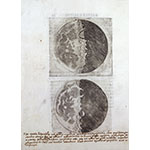The Sidereus Nuncius is the work in which Galileo announced the discovery of Jupiter's moons. Using drawings and illustrations, he analyzed the new celestial phenomena observed with the telescope in Padua in early 1610. The work initiated a process that would lead, in a few decades, to the acceptance of the Copernican system despite opposition from ecclesiastical authorities. The work's publication and its dedication to the Medici of Jupiter's moons (which Galileo named the "Medicean Stars") opened the path for the return of Galileo to Tuscany, Cosimo II having appointed him Granducal Mathematician and Philosopher. A few months after the Sidereus Nuncius appeared, the Pisan scientist observed "three-bodied Saturn," sunspots, and the phases of Venus, which provided further evidence against the Aristotelian-Ptolemaic system.









